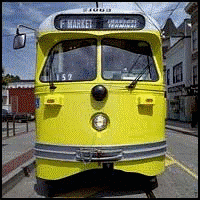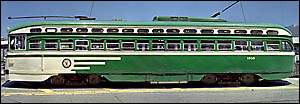They say history repeats itself and that eventually things come around again, but the reality is that most things never do. However, the street car in America is proving to be an exception. But while groups in cities like Cincinnati sell posters exclaiming "Deja Vu! Bring Back The Trolley," other cities never quite forgot the marvels of public transit on rails. San Francisco is one of those cities.
While other cities lament that no street cars native to their region survived the era of the automobile, many of the cars running today in the city by the bay knew the streets when the Golden Gate Bridge was new and street cars were king. Like many other cities looking to build or expand street car systems or connect tourist attractions with light rail, San Francisco is using street cars, some a century old, to connect tourist destinations as well as shuttle commuters and office workers.
 An example is the F-Line, which currently runs from the famous Ferry Building at the foot of Market Street to the Castro, a residential and commercial area. The line has been rebuilt and reinvigorated with brightly-painted cars carrying the monikers of fabled street car lines throughout the United States. This "Market Street Railway" has been so successful and popular with tourists that commercial tenants along the route complain that the trolleys are making rents for the retail stores unaffordable!
An example is the F-Line, which currently runs from the famous Ferry Building at the foot of Market Street to the Castro, a residential and commercial area. The line has been rebuilt and reinvigorated with brightly-painted cars carrying the monikers of fabled street car lines throughout the United States. This "Market Street Railway" has been so successful and popular with tourists that commercial tenants along the route complain that the trolleys are making rents for the retail stores unaffordable!
Long-time proponents of fixed-rail public transit always knew that street cars were good for urban businesses and neighborhoods. Plans are in place to extend the line, possibly making a giant loop around the city. With frequent stops, the street cars make walking practical. They keep riders at surface level where they can window shop, wander and keep an eye on the sidewalk. The busy streets discourage criminal activity as well as provide customers for retailers.
Furthermore, the fixed nature of street car routes supplies a permanent stream of pedestrians that can't be taken away by changing a bus schedule. "The street car solution is like a marriage," says Dr. Dave Fritze, a member of a group trying to bring street cars back to Cincinnati. "When you put down rails through a neighborhood, you indicate you intend to stay there. A bus can be on one route today and leave the neighborhood behind tomorrow. The difference is commitment."
And while retailers can be assured by the permanent nature of street cars, and commuters enjoy the unique way of getting to work, tourists are also attracted to the cars, bringing a new set of riders to mass transit and boosting ridership numbers. Visiting from all corners of the globe, the same tourists who avoid busses flock to street cars. While the smelly bus is something to be avoided, the squeaky street car, emanating a yellow glow from the interior lights, is seen as charming. "Street cars provide an experience unique to San Francisco," says Jay Wong, a native to the city who grew up riding some of the same cars operating today. "We used to take them for granted. But at one time cable cars also used to run in many cities. What others discarded, San Francisco held on to, and soon the city will be known for its street cars as much as it is for its cable cars."
The street cars have gone beyond their historical role as a good way to get around and more than proven to be a good way to see San Francisco. New plans are constantly in the works to find more cars and expand the system. The street cars not only bring more tourists to Market Street, but connect most of the city's tourist attractions including Fisherman's Wharf, the cable cars and the Giants Stadium with the Castro. If a proposed plan is adopted, the cars may also extend into Golden Gate Park and other locations.
"The street cars are a perfect way to see the city," Wong says. "From the city's origins along the wharf, up Market Street through the financial district, past some of the offices of the early industrialists, to the great department stores and hotels in Union Square, to the recently restored beaux arts City Hall." It's a trip that wouldn't be the same on a diesel bus. "Suburban tourists won't ride a bus, but they will take a historic street car," explained Market Street Railway volunteer Mike Smith. (It isn't by accident that the cars provide a great way to see the city. The Market Street Railway is a non-profit group of volunteers who find, restore and keep the cars clean and in good repair.)
When the landscaping is complete and the Embarcadero line opens early in 2000, the cars will also connect other destinations like Giants Stadium and Fisherman's Wharf.
The new line which runs perpendicular to Market Street has been built on the site of the now demolished Embarcadero Freeway, which was badly damaged in the 1989 Loma Prieta earthquake. Running along the waterfront, the street cars provide visitors with their first and most lasting impressions of the city. Once a dark area in the shadow of a concrete freeway, the piers on the bay are now visible and connected with the rest of the city. The street cars will travel on a granite path alongside palm trees from Pier 39 to the Ferry Building.
Other commercial and entertainment developments are expected to make the area along the Embarcadero a premier destination for the city. Currently new hotels and an organ pavilion will accessible from the new line. Not yet completed, the area is already becoming a magnet for San Franciscan's during weekday lunch hours.
The idea to connect the street cars to one of the best urban parks in the country was suggested as an alternative to building a parking garage for a rebuilt De Young museum. Market Street Railway President Art Michel said that expanding tracks into Golden Gate Park would provide access for tourists staying at downtown hotels and eliminate the need for a garage by connecting the De Young and other attractions in the park to a garage just outside the parks borders. Advocates say the plan would help preserve one of urban America's great retreats by keeping as much automobile traffic as possible out of Golden Gate Park.
Street cars haven't always been an easy sell, as the rocky history of the system suggests. Some of the same cars that run on Market Street today ran there in the 1960s when a plan was announced to put the tracks underground. The tracks were preserved, however, because it became obvious bus routes couldn't handle the traffic diverted from Market Street. Then in 1983 the city's cable cars were scheduled to be overhauled--which was bad news for the tourist industry, but good news for San Francisco's street cars. The Chamber of Commerce, MUNI and the city came up with the idea for "historic" street cars which would run on the Market Street tracks to keep tourist dollars flowing while the cable cars were out of service.
After five years of operation, a period known as the "Trolley Festival," the line was in no condition to keep running indefinitely. The old cars built before the depression also required a two-man crew to operate them, an expense that would limit the long-term use and expansion of the system. So, keeping the historic street car line operating presented a serious dilemma--where do you find enough cars to expand and operate the line indefinitely?
The search took Market Street Railway volunteers as far away as Russia and Italy and even Philadelphia. In fact, most of the single-ended World War II era PCC cars running today were brought to San Francisco from suburban Philadelphia. They have been painted to represent street car lines around the country, including Brooklyn, Newark, Louisville and Chicago. "Market Street is a little drab in some places so they add a bit color to town," says volunteer Dave Pharr. Some of the cars, the double-ended PCCs, are native to San Francisco.
A third type of car that regularly makes run from Trans Bay Terminal to the Castro is the boxier looking model from Milan, Italy. Complete with advertising signs still posted in Italian, the cars are decorated with wood and have large windows perfect for sight-seeing.
These cars came from the same city as the newer light-rail cars that run on the N-Judah line. At $70,000 including shipping, the historic cars are a fraction of the $3 million cost for a new car. Volunteers say that MUNI could learn a lot from the old cars too. "They're reliable," says Dave Pharr explaining that the F-line continues to run when MUNI goes down. "The newer cars are sophisticated and complicated and MUNI has trouble taking care of something like that," Pharr says, adding that eight men take care of the street cars while over 200 MUNI employees maintain the subway-surface cars.
 The street cars have benefited San Francisco in many ways and are quickly becoming as much a part of the city as the
cable cars and Golden Gate Bridge. But more than that, the ever-expanding Market Street Railway provides a great way to
see this historic city the way visitors and residents saw it long ago, before the tyranny of the automobile. San Francisco is a great place to see under any conditions, but the view is even better from the window of a street car.
The street cars have benefited San Francisco in many ways and are quickly becoming as much a part of the city as the
cable cars and Golden Gate Bridge. But more than that, the ever-expanding Market Street Railway provides a great way to
see this historic city the way visitors and residents saw it long ago, before the tyranny of the automobile. San Francisco is a great place to see under any conditions, but the view is even better from the window of a street car.
Eric Miller
Photographs © 1998 the archive of light--all rights reserved

